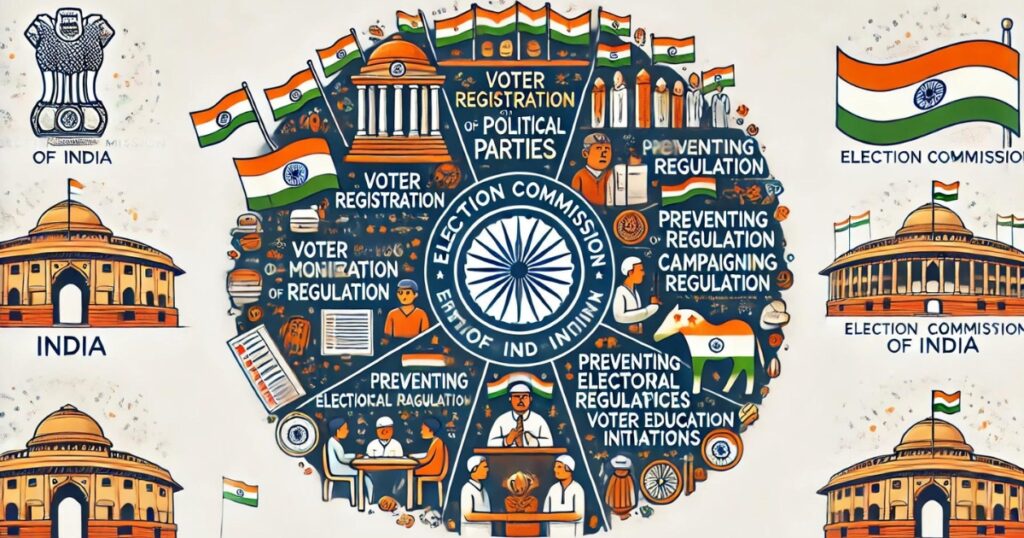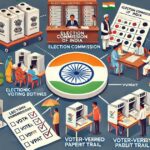The Electoral Process is the main fundamental of the Election Commission of India (ECI), established in 1950, and it is a constitutional authority tasked with administering elections in India to ensure they are conducted in a free and fair manner.
The ECI plays a crucial role in the democratic process of India. This blog post outlines the electoral process, detailing the role of the ECI, how elections are conducted, the challenges faced, and potential reforms to enhance the electoral system.
The Election Commission’s efforts are crucial to maintaining trust in the democratic machinery and ensuring that the citizens’ voices are effectively represented through a robust and transparent electoral process.
Overview of the Election Commission of India:
The Election Commission of India is an autonomous constitutional authority responsible for ensuring transparent, unbiased, and efficient elections.
The ECI oversees elections for the President, Vice President, Parliament, State Legislative Assemblies, and local bodies.
The ECI is designed to function independently, and free from political interference, and its primary mandate is to uphold the integrity of the election process, which is essential for maintaining a vibrant democracy.
Composition of the Election Commission
The Election Commission consists of the Chief Election Commissioner (CEC) and two Election Commissioners (ECs).
Initially a single-member body, the Election Commission became a multi-member body with two Election Commissioners appointed on October 16, 1989.
It reverted to a single-member body on January 2, 1990, and then became a permanent three-member commission from October 1, 1993, to ensure greater transparency and collective decision-making.
The CEC and ECs are appointed by the President of India. They serve for a term of six years or until reaching the age of 65, whichever comes first.
The multi-member body ensures that decisions are made collectively, promoting transparency and reducing the likelihood of bias in decision-making.
Key Points:
Constitutional Provision: Article 324 of the Indian Constitution establishes the Election Commission.
Composition: One Chief Election Commissioner and two Election Commissioners.
Tenure: Six years or until the age of 65.
Appointment Process: The CEC and ECs are appointed by the President of India, ensuring that they are independent of political influence.
Roles: Election Commission:

The Election Commission has several key responsibilities aimed at ensuring free and fair elections:
1. Preparation of Electoral Rolls:
The ECI is responsible for preparing and updating the electoral rolls to ensure all eligible citizens can participate in elections.
This includes adding new voters who have reached the eligible age and removing names of deceased individuals or those who are otherwise disqualified.
2. Conduct of Elections:
The ECI conducts elections for the President, Vice President, Lok Sabha, Rajya Sabha, and State Legislative Assemblies, as well as local body elections.
It ensures that all aspects of the electoral process, including nominations, campaigning, polling, and counting, are managed smoothly.
3. Supervision and Control:
The ECI supervises the entire election process, from announcing election dates to declaring results. This supervision extends to ensuring that all stakeholders, including candidates and voters, adhere to the established guidelines.
4. Monitoring Political Parties:
The ECI registers political parties and monitors their activities to ensure adherence to the Model Code of Conduct (MCC). The MCC is a set of guidelines to ensure that political parties conduct their campaigns in an ethical manner.
5. Preventing Electoral Malpractices:
The ECI takes measures to prevent electoral malpractices, ensuring a level playing field for all parties.
This includes monitoring campaign expenditures, preventing vote buying, and ensuring that polling is conducted without any coercion.
6. Voter Education:
The ECI implements voter education programs to increase voter awareness and participation.
Through initiatives like the Systematic Voters’ Education and Electoral Participation (SVEEP) program, the ECI aims to educate voters about their rights and the importance of participating in the democratic process.
The Electoral Process in India:
The electoral process in India comprises several stages essential for the functioning of democracy:
1. Delimitation of Constituencies
Delimitation involves the demarcation of electoral boundaries to ensure balanced representation. The Delimitation Commission redefines constituencies periodically to reflect population changes.
This ensures that each constituency has roughly the same number of voters, which is crucial for fair representation in the legislative bodies.
2. Preparation and Updating of Electoral Rolls
Electoral rolls list eligible voters in each constituency. The ECI periodically updates these rolls, conducting a major drive known as the “Special Summary Revision” annually.
The revision ensures that the electoral roll is accurate and up to date, including new voters and removing those who are no longer eligible.
3. Announcement of Election Schedule
The ECI announces the election schedule after consultations with political parties and government authorities, detailing dates for nominations, scrutiny, withdrawal, polling, and counting of votes.
The schedule is designed to ensure that all stakeholders have adequate time to prepare, ensuring a smooth electoral process.
4. Filing of Nominations
Candidates file their nomination papers within a specified timeframe, and the Returning Officer scrutinizes the nominations for eligibility compliance.
This process ensures that only eligible candidates are allowed to contest the elections. The scrutiny process involves verifying the candidate’s qualifications, such as educational degrees, background, and adherence to the legal requirements.
5. Campaigning
Political parties and candidates campaign once nominations are finalized. The ECI enforces the Model Code of Conduct (MCC) to regulate campaign activities, restricting the use of government resources and ensuring a fair campaign environment.
Campaigning is a crucial part of the electoral process, allowing candidates to present their vision and policies to the electorate through methods such as rallies, debates, and public meetings.
The MCC ensures that no party has an unfair advantage and that the campaign remains focused on issues rather than personal attacks.
6. Polling and Voting
Polling is conducted in phases to address logistical challenges and ensure security, enabling smooth functioning throughout the process.
Electronic Voting Machines (EVMs), first introduced in the 1990s, and Voter-Verified Paper Audit Trails (VVPATs) are used, and polling booths are set up for voters to cast their ballots.
The ECI makes elaborate arrangements to ensure that polling is accessible to all citizens, including persons with disabilities.
Security personnel are deployed to maintain order, and polling officers are trained to assist voters.
7. Counting of Votes and Declaration of Results
After polling, the ECI oversees the counting of votes. The results are declared, and winning candidates receive certificates of election, which officially confirm their victory and eligibility to hold office.
The entire counting process is closely monitored to ensure transparency and accuracy. Representatives of political parties are allowed to observe the counting process to maintain confidence in the integrity of the results.
Key Features:
1. Electronic Voting Machines (EVMs):
Introduced in the 1990s, EVMs have streamlined the voting process by reducing errors, minimizing fraud, and enabling quicker counting.
EVMs have helped in making the electoral process more efficient and less prone to human error compared to traditional paper ballots.
2. Model Code of Conduct (MCC):
The MCC provides guidelines for political parties and candidates during the campaign period, ensuring ethical conduct.
It ensures that public resources are not misused for election purposes and that political debates focus on policies rather than personal attacks.
3. Voter-Verified Paper Audit Trail (VVPAT):
VVPATs provide voters with a paper verification of their vote, enhancing transparency.
The use of VVPATs has helped build voter confidence, as they can see a physical printout of their vote, ensuring that it has been recorded accurately.
Challenges Faced by the Election Commission
The Election Commission faces several challenges in conducting free and fair elections:
1. Money Power:
The increasing influence of money in elections is a significant concern, as political parties spend large amounts on campaigns, potentially leading to unfair advantages.
Campaign finance reform has been suggested to address this issue, ensuring that elections are not influenced by financial power.
2. Criminalization of Politics:
The presence of candidates with criminal backgrounds continues to be an issue. In the 2019 general elections, 43% of elected Members of Parliament had criminal charges.
This undermines public trust in the democratic process, and reforms are needed to prevent individuals with serious criminal charges from contesting elections.
3. Low Voter Turnout:
Despite voter education initiatives, voter turnout remains a challenge, especially in urban areas.
The ECI has been working to improve voter participation through awareness campaigns, but more needs to be done to engage urban voters and address apathy.
4. Fake News and Misinformation:
The spread of misinformation via social media poses a challenge for the ECI during elections.
The ECI collaborates with social media platforms to curb misinformation, but the rapid spread of fake news remains a significant threat to informed voting.
5. Booth Capturing and Violence:
Incidents of booth capturing and violence still occur in some regions, affecting the integrity of elections.
The deployment of security forces and strict monitoring by the ECI have helped reduce such incidents, but vigilance is still required in sensitive areas.
Proposed Reforms:
To enhance transparency and efficiency, several reforms have been suggested:
1. State Funding of Elections:
State funding has been proposed to reduce the influence of money in elections, ensuring a level playing field.
By providing public funds for campaigns, candidates would be less reliant on private donations, reducing the risk of undue influence by wealthy donors.
2. De-criminalization of Politics:
Reforms are needed to prevent candidates with criminal charges from contesting elections.
This includes stricter screening processes and legal measures to bar individuals with serious charges from standing for election.
3. Strengthening Voter Awareness:
Greater emphasis on voter education is needed to increase voter participation.
Initiatives such as voter awareness campaigns in schools and colleges, as well as community outreach programs, can help educate citizens about the importance of voting.
4. Use of Technology:
Increased use of artificial intelligence and blockchain technology can further improve the transparency of elections.
AI can help monitor social media for misinformation, while blockchain could be used to secure, tamper-proof voting systems.
5. Regulation of Social Media:
Stricter regulations for social media during elections are necessary to curb misinformation.
Collaborations with tech companies to monitor content and remove misleading information are essential for ensuring that voters receive accurate information.
Achievements of the Election Commission
The Election Commission has made significant achievements in ensuring fair elections:
1. Largest Electoral Exercise:
The 2019 general elections, involving over 900 million eligible voters, were the largest democratic exercise in history.
The successful management of such a large-scale election demonstrates the ECI’s capability and organizational strength.
2. Introduction of NOTA:
The “None of the Above” (NOTA) option empowers voters to reject all candidates if none are deemed suitable.
This provides an opportunity for voters to express dissatisfaction with the available choices and sends a message to political parties to nominate better candidates.
3. Voter Education Initiatives:
Campaigns like the Systematic Voters’ Education and Electoral Participation (SVEEP) program aim to increase voter awareness and participation.
These initiatives have contributed to higher voter turnout in many regions by educating citizens about the importance of their vote.
4. Accessible Elections:
The ECI has made elections accessible to persons with disabilities by providing facilities such as wheelchairs and Braille EVMs.
The emphasis on inclusivity ensures that all citizens can exercise their voting rights regardless of physical ability.
5. Use of Technology:
The adoption of EVMs, VVPATs, and other technological innovations has modernized the electoral process, making it more efficient and transparent.
The ECI has also developed mobile apps to provide election-related information to voters and facilitate grievance redressal.
Importance of Free and Fair Elections:
1. Free and fair elections are fundamental to a functioning democracy. They provide legitimacy to the government, ensure the representation of citizens’ interests, and hold elected representatives accountable.
2. The Election Commission’s role in safeguarding the integrity of elections is crucial for maintaining public trust in the democratic process.
3. This is achieved through monitoring compliance with electoral laws, using technology such as EVMs and VVPATs, and enforcing the Model Code of Conduct.
4. Without free and fair elections, the democratic system would lose its credibility, and the government would lack the mandate to govern effectively.
You can read: How AI Is Changing Governance and Elections: Revolution or Risk?
Conclusion:
The Election Commission of India plays a crucial role in ensuring that the electoral process is conducted transparently and efficiently.
Despite challenges, the ECI has made substantial progress in maintaining the integrity of elections. Continued reforms, technological adoption, and voter education are vital for strengthening India’s democratic process.
The role of citizens in actively participating in elections and holding representatives accountable cannot be overstated, as it is the cornerstone of a thriving democracy.
Frequently Asked Questions (FAQs)
1. What is the role of the Election Commission of India?
The Election Commission of India conducts free and fair elections for the Lok Sabha, Rajya Sabha, State Legislative Assemblies, and the offices of the President and Vice President, overseeing the entire electoral process. It ensures that all aspects of the election, from voter registration to result declaration, are conducted transparent and unbiasedly.
2. What are Electronic Voting Machines (EVMs)?
Electronic Voting Machines are devices used for casting votes during elections, reducing manual errors and ensuring an efficient voting process. EVMs have replaced traditional paper ballots, making the voting process faster and more secure.
3. What is the Model Code of Conduct (MCC)?
The Model Code of Conduct regulates the behaviour of political parties and candidates during elections to ensure ethical conduct. It is designed to create a level playing field, preventing the misuse of government resources and ensuring that campaigns are conducted fairly.
4. How does the ECI ensure transparency in elections?
The ECI uses EVMs, VVPATs, and voter education initiatives to ensure transparency, while also enforcing the Model Code of Conduct. The use of technology, such as EVMs and VVPATs, has made the voting and counting processes more transparent, and the MCC ensures ethical conduct during campaigns.
5. What are the challenges faced by the Election Commission of India?
Challenges include the influence of money power, criminalization of politics, misinformation, and ensuring voter turnout. These challenges undermine the fairness of elections, and the ECI is continually working on measures to address them.
6. What is NOTA in the context of Indian elections?
NOTA, or “None of the Above,” is an option available to voters if they do not find any candidate suitable. It allows voters to reject all candidates contesting an election. NOTA was introduced to give voters the right to express their dissatisfaction with the candidates.
7. What measures are taken to ensure accessible elections for persons with disabilities?
The Election Commission of India provides facilities such as wheelchairs, ramps, and Braille EVMs to ensure that persons with disabilities can participate in the voting process. The ECI is committed to making the electoral process inclusive, ensuring that every eligible voter can exercise their right to vote.
8. How does the ECI tackle the issue of misinformation during elections?
The ECI works with social media platforms to monitor and curb misinformation. It also runs voter awareness campaigns to educate citizens about the importance of accurate information. The ECI’s collaboration with tech companies helps remove misleading content and ensures that voters make informed decisions.
9. What is the role of the Delimitation Commission?
The Delimitation Commission is responsible for redefining the boundaries of constituencies to ensure balanced representation based on population changes. Delimitation ensures that each constituency has an approximately equal number of voters, which is essential for fair representation in the legislative bodies.
10. What are Voter-Verified Paper Audit Trails (VVPATs)?
VVPATs are devices used alongside EVMs to provide voters with a printed record of their vote. This enhances transparency and helps verify that votes are correctly recorded. VVPATs allow for greater accountability, as they can be used to cross-check the electronic count in case of disputes.
People Also Read: Major Determinants Of Elections










